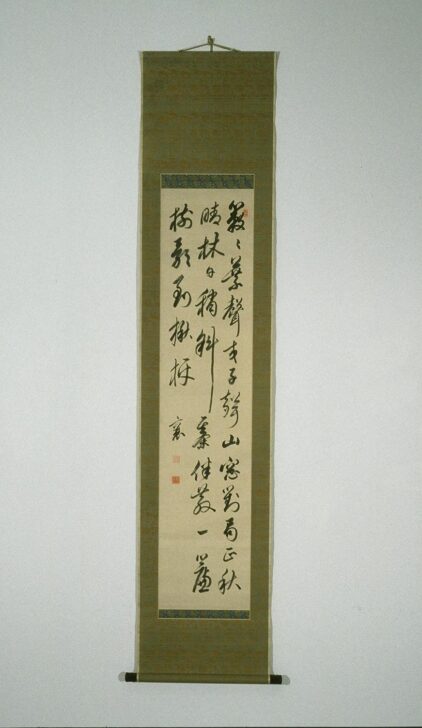The Sound of Rustling Leaves (Chinese poem, calligraphy)
Rai San'yō

Description
San’yô was the son of a noted Confucian scholar who served in an official post in Aki (modern Hiroshima Prefecture). After studying national history and economics in Edo, San’yô returned home, but for an infraction of a local regulation, he was confined to three years’ house arrest. During this time he wrote An Unofficial History of Japan, which would win him the reputation as one of the leading intellectuals of the day. In 1811 he founded a school in Kyoto, where he nurtured many young writers and artists, including several shown in this exhibition.
San’yô was also a fine calligrapher. The poem inscribed here is so vividly pictorial that it may have been written in response to a painting very like that of Tanomura Chokunyû (no. 13):
The sounds of rustling leaves and the voices of talented men;
by the window of the mountain villa, a man plays go [Chinese chess] with another on a fine autumn day.
The sun in the forest begins to set and the match breaks up;
the shadow of a tree reaches from the bamboo blind to the catalpa chess-board.
Maribeth Graybill, for the exhibition "Japanese Visions of China,"
9/21/02 - 1/26/03
--
Rai San’yô was the son of a noted Confucian scholar who served in an official post in Aki (modern Hiroshima Prefecture). After studying national history and economics in Edo, San’yô returned home, where he was put under house arrest for three years for an infraction of a local regulation. During this time he wrote An Unofficial History of Japan, which would win him a reputation as one of the leading intellectuals of the day. In 1811 he founded a school in Kyoto where he nurtured many young writers and artists.
San’yô was also a fine calligrapher. The poem inscribed here is so vividly pictorial that it may have been written in response to a painting:
The sounds of rustling leaves and the voices of talented men;
by the window of the mountain villa, a man plays go [Chinese chess] with another on a fine autumn day.
The sun in the forest begins to set and the match breaks up;
the shadow of a tree reaches from the bamboo blind to the catalpa chess-board.
Gallery Roatation Spring 2011
Gallery Rotation Spring/Summer 2011
Rai San’yô
Japan, active circa 1780–1832
The Sound of Rustling Leaves
circa 1811–32
Edo Period (1615–1868)
Hanging scroll, ink on paper
Museum purchase made possible by the Margaret Watson Parker Art Collection Fund, 2002/1.164
Rai San’yô was the son of a noted Confucian scholar who served in an official post in Aki (modern Hiroshima Prefecture). After studying national history and economics in Edo, San’yô returned home, where he was put under house arrest for three years for an infraction of a local regulation. During this time he wrote An Unofficial History of Japan, which would win him a reputation as one of the leading intellectuals of the day. In 1811 he founded a school in Kyoto where he nurtured many young writers and artists.
San’yô was also a fine calligrapher. The poem inscribed here is so vividly pictorial that it may have been written in response to a painting:
The sounds of rustling leaves and the voices of talented men;
by the window of the mountain villa, a man plays go [Chinese chess] with another on a fine autumn day.
The sun in the forest begins to set and the match breaks up;
the shadow of a tree reaches from the bamboo blind to the catalpa chess-board.
Subject Matter:
This is the poem:
The sounds of rustling leaves and the voices of talented men;
by the window of the mountain villa, a man plays go [Chinese chess] with another on a fine autumn day.
The sun in the forest begins to set and the match breaks up;
the shadow of a tree reaches from the bamboo blind to the catalpa chess-board.
Physical Description:
This is a hanging scroll. It is mounted on olive green fabric and includes a poem in Chinese calligraphic text about nature. Has three red seals: two in the lower left side, one in the upper right corner.
Usage Rights:
If you are interested in using an image for a publication, please visit https://umma.umich.edu/request-image/ for more information and to fill out the online Image Rights and Reproductions Request Form.